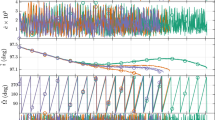Abstract
The SMF algorithms were recently developed by the authors as a multistep generalization of the ScheifeleG-functions one-step method. Like the last, the proposed codes integrate harmonic oscillations without truncation error and the perturbing parameter appears as a factor of that error when integrating perturbed oscillations. Therefore they seemed to be convenient for the accurate integration of orbital problems after the application of linearizing transformations, such as KS or BF. In this paper we present several numerical experiments concerning the propagation of Earth satellite orbits, that illustrate the performance of the the SMF method. In general, it provides greater accuracy than the usual standard algorithms for similar computational cost.
Similar content being viewed by others
References
Battin, R. H.: 1987,An Introduction to the Mathematics and Methods of Astrodynamics, AIAA Professional Study Series.
Bettis, D. G.: 1970a, Numerical integration of products of Fourier and ordinary polynomials,Numer. Math. 14, 421–434.
Bettis, D. G.: 1970b, Stabilization of finite difference methods of numerical integration,Celest. Mech. 2, 282–295.
Burdet, C. A.: 1969, Le mouvement Keplerien et les oscillateurs harmoniques,J. reine und angew. Math. 238, 71.
Dormand J. R. and Prince P. J.: 1978, New Runge-Kutta algorithms for numerical simulation in Dynamical Astronomy,Celest. Mech. 18, 223–232.
Ferrándiz, J. M.: 1986, A new set of canonical variables for orbit calculation, In:Proceedings of the Second International Symposium on Spacecraft Flight Dynamics, ESA SP-255, pp. 361–364, Darmstadt, Germany.
Ferrándiz, J. M.: 1988, A general canonical transformation increasing the number of variables with application to the two-body problem,Celest. Mech. 41, 345–357.
Ferrándiz, J. M. and Sansaturio, M. E.: 1989, Elemento de tiempo en variables de Ferrándiz,Actas XIV Jornados Hispano-Lusas de Matemáticas, Vol. III, 1231–1235.
Ferrándiz, J. M., Sansaturio, M. E. and Pojman, J. R.: 1992a, Increased Accuracy of Computation in the Main Satellite Problem through Linearization Methods,Celest. Mech. & Dyn. Astron. 53, 347–363.
Ferrándiz, J. M., Sansaturio, M. E. and Vigo, J.: 1991, Long time predictions of satellite orbits by numerical integration, in Roy, A. E. (ed.),Predictability, Stability and Chaos in N -Body Dynamical Systems, NATO ASI Series B Vol. 272, pp. 387–394, Plenum Publishing Corporation.
Ferrándiz, J. M., Sansaturio, M. E. and Vigo, J.: 1992b, On the accurate numerical computation of highly eccentric orbits, in: Diehl, R. E.et al. (eds.),Advances in the Astronautical Sciences, Vol. 79, pp. 1185–1204, Univelt Inc., San Diego.
Fox, K.: 1984, Numerical integration of the equations of motion of Celestial Mechanics,Celest. Mech. 33, 127–142.
Hairer, E., Nørsett, S. P. and Wanner, G.: 1987,Solving Ordinary Differential Equations I, Springer, Berlin.
Herrick, S.: 1965, Universal variables,Astron. J. 70, 309–315.
Kinoshita, H. and Nakai, H.: 1989, Numerical integration methods in Dynamical Astronomy,Celest. Mech. 45, 231–244.
Martín, P.: 1992,Extensiones del método de Scheifele para la integración numérica de osciladores y sistemas lineales perturbados, Ph.D. Dissertation, University of Valladolid (Spanish language). Available from the author.
Martín, P. and Ferrándiz, J. M.: 1993, Relative behaviour of special algorithms for the numerical integration of satellite orbits,Advances in the Astronautical Sciences 82, 765–782.
Martín, P. and Ferrándiz, J. M.: 1995, A family of multistep numerical methods based on the ScheifeleG-functions to integrate perturbed oscillators,SIAM Journal on Numerical Analysis (in press).
Montenbruck, O.: 1992, Numerical integration methods for orbital motion,Celest. Mech. & Dyn. Astron. 53, 59–69.
Nacozy, P.: 1981, Time elements in Keplerian orbital elements,Celest. Mech. 23, 173–198.
Scheifele, G.: 1971, On numerical integration of perturbed linear oscillating systems,ZAMP 22, 186–210.
Steffensen, J. F.: 1955a, On the differential equations of Hill in the theory of the motion of the Moon,Acta Mathematica 93, 169–177.
Steffensen, J. F.: 1955b, On the differential equations of Hill in the theory of the motion of the Moon (II),Acta Mathematica 95, 25–37.
Steffensen, J. F.: 1956, On the restricted problem of three bodies,Mat. Fys. Medd. Dan. Vid. Selsk. 30 (18).
Stiefel, E. L. and Bettis, D. G.: 1969, Stabilization of Cowell's Method,Numer Math. 13, 154–175.
Stiefel, E. L. and Scheifele, G.: 1971,Linear and Regular Celestial Mechanics, Springer, New York.
Stumpff, K.: 1959,Himmelsmechanik, VEB Deutscher Verlag der Wissenschaften, Berlin.
Szebehely, V. G.: 1976, Lectures on linearizing transformations, inLong-Time Predictions in Dynamics, pp. 17–42, D. Reidel Publ. Co., Dordrecht, Holland.
Taff, L. G.: 1985,Celestial Mechanics, Wiley-Interscience, New York.
Author information
Authors and Affiliations
Rights and permissions
About this article
Cite this article
Martín, P., Ferrándiz, J.M. Behaviour of the SMF method for the numerical integration of satellite orbits. Celestial Mech Dyn Astr 63, 29–40 (1995). https://doi.org/10.1007/BF00691913
Received:
Accepted:
Issue Date:
DOI: https://doi.org/10.1007/BF00691913




